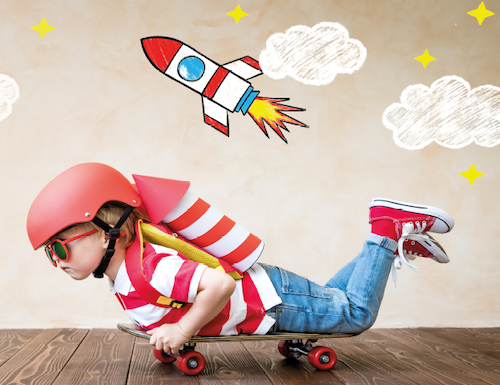How to Prepare Your Child for a Rapidly Changing World
Developing curiosity and creativity from an early age is the key to helping our children survive and thrive.

Our world is rapidly evolving. It's difficult to predict precisely when and how artificial intelligence (or 'AI') will change the world our children will inherit, but one thing is certain: the world will continue to change, and the pace of change will only increase.
It is my firm belief (supported by science!) that growing curiosity and creativity in our children will prepare them to be able to adapt, innovate, and thrive in a world that our parents could only imagine.
Tools like the free AI headshot generator at Portrait Pal offer a glimpse into the practical applications of AI that our children might use or even create in the future.
Why Curiosity and Creativity?
Think of curiosity and creativity as best friends — they work together and strengthen each other. You'll see a little spark when babies and young children are curious about the world around them. Their eyes are wide, and you can see their determination and motivation to learn more.
The benefits of curiosity in developing minds are extensive. Curious children exhibit enhanced memory and retention skills. Their minds are prepared to adapt to new concepts, building reservoirs of knowledge and skills and the ability to connect to others as they listen and consider other perspectives.
Children are naturally inquisitive; when we provide them with opportunities to be curious and creative, their problem-solving skills will increase, and we know that children will need those skills in the future. Studies even indicate that curious children tend to possess higher emotional intelligence and empathy as they seek to understand different perspectives. Curiosity breeds adaptability and resilience, and this helps children become comfortable with uncertainty and change. Again, dispositions that we want to nurture in our children, because we know uncertainty and rapid change is coming at us at a rate of knots.
Your Child's Most Important Educator
While every child is unique, with distinct character traits, personalities, and learning dispositions, what we do as adults in those earliest years significantly impacts our developing child.
As parents, we are our child's first and foremost educator, and by nurturing a curiosity-driven and creative mindset in a child's earliest years, we not only support development but also lay the groundwork for a lifelong love of learning.
Let’s explore a scenario.
Your baby has spied an interesting ball, but it's far away. As adults, we recognise that they want the ball, and your baby could have already learned that looking at something and crying out loud gets them what they want. But what if we were to think about this situation in another way?
The ball is just out of reach, and the problem of getting the ball needs to be solved. Your baby has already developed lots of physical actions: reaching, stretching, looking, grasping, kicking, rolling, lifting, and is ready to put these skills to use to establish a new and exciting action – crawling. Developmentally, crawling, bottom shuffling or moving in any way is necessary for another vital developmental step: walking.
Suppose we solve our child's problem by giving them the ball. In that case, we aren't allowing them to develop their actions and see them as valuable tools to find out about the world around them. The valuable tool they'll have to hand is crying or demanding an item they want - and any parent of older children will want to go back and tell their younger selves not to feed into that!
Curiosity drives action, and actions allow interest to expand the mind. Giving your child the ball might seem like a great solution in the short term, but the long-term effect could be that your child won't see themselves as a learner.
Over time, given less opportunity to be curious and take action to solve their problems for themselves could lead to a poor relationship with the superhero that is creativity.
It Will Be Challenging
What does this journey to develop curiosity look like? Well, in truth, it's likely to be challenging for you.
Asking lots of questions, taking apart toys, throwing things, and posting things through the letterbox: that's curiosity in action. Creativity works hand in hand with curiosity, a match made in heaven for every future self.
So, what is your child thinking that makes them curious?
‘I wonder what would happen if’ …. I jumped off this chair; put the keys through here; tipped this upside down; hid here; said this; ran there. All potentially challenging situations for you as a parent!
No one wants a child to hurt themselves jumping, lose their keys, tidy up a bucket full of toys, think a child has been kidnapped only to discover they are keeping quiet under the bed, answer the same question for the 53rd time or go out of your comfort zone when a child runs ahead. All those situations make us feel vulnerable, out of control, frustrated and infuriated.
Still, they are all feelings that, as emotionally mature adults, we can think differently about. These are opportunities to talk about consequences, teach about keeping safe, explain about danger, or describe how you feel. Ask your child to solve the problem that you're feeling. Their creative response may surprise you!
Nurturing curiosity and creativity in children is vital - and now more so than ever.
Encourage your child to try new things, take small risks, and think in unique ways —you'll be helping them think 'outside the box'. Blue sky thinking or trying to find new ideas and solutions is a skill we know will be needed in the future.
The Power of Language… and Toys!
As parents, we play a pivotal role in nurturing daily curiosity and creativity from birth. Using simple open-ended questions serves to stimulate imagination and critical thinking. "I wonder what..." and, "What would happen if..." questions give even very young children the chance to exercise their inquisitiveness.
Providing toys and activities for exploration and discovery is crucial as well. And, just as the language we use should be open-ended, the things we give our children to play with must be open-ended, too.
Open-ended playthings are versatile resources that encourage creativity, imagination, and exploration. Simple open-ended resources such as building blocks, play dough, art supplies and dress-up clothes create an environment that fosters creativity and imagination. Nature materials, loose parts, and even cardboard boxes offer endless possibilities for exploration and play. The possibilities for creativity are limited only to your own curiosity and creativity.
Think back to how you played as a child: what were you doing, how did it feel? Would you have liked to play differently? Be a partner in your child’s play and exploration. Children like nothing more than having this quality time with you.
Your child will have strong feelings about the way they want to play. You may find that they have a particular interest or obsession. It’s important to acknowledge this and encourage your child to learn more about what they are interested in. Creativity soars when an interest is ignited, allowed to grow and respected, and there is always more to learn about any subject.
Children raised with values around being curious and creative have the best chance of becoming independent learners with an enduring sense of wonder. Both skills will equip them with whatever the future holds and it’s an exciting journey to be on.

Alison Featherbe provides consultancy and training to early years providers. She is a leading authority in the Early Years Foundation Stage and works with providers to build family partnerships built on trust, involvement and shared expectations. Follow ‘Alison Featherbe Learning & Development’ on Twitter (X), Instagram and LinkedIn.